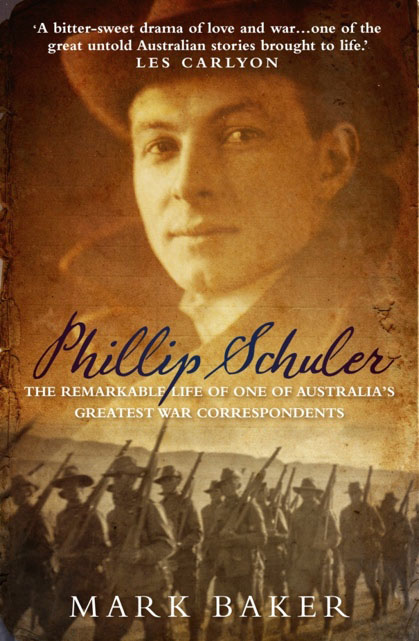Phillip Schuler, a handsome young journalist from the Melbourne Age, covered the Gallipoli campaign alongside Charles Bean. His bravery was legendary. His dispatches were evocative and compassionate. He captured the heroism and horror for Australian newspaper readers in ways the meticulous yet dry prose of Bean never could. After Schuler’s classic account of the campaign, Australia in Arms, was completed in early 1916, Schuler abandoned the relative safety of a correspondent’s job and joined the Australian Imperial Force (AIF) as a humble soldier. In June 1917, he was killed in Flanders. He was 27 years old.
Phillip Schuler is a biography of one of Australia’s greatest war correspondents, from Gallipoli to his death in Flanders. Mark Baker’s meticulously researched and easy-to-read account of Schuler’s brief but extraordinary life gives a tremendous insight into the man.
Schuler was born in East Melbourne in 1889 and as a young man served in the militia in the 5th Battalion. In February 1911 he transferred to the Australian Intelligence Corps as a second lieutenant, being assigned to the Australian Service Corps a year later. Schuler was a junior reporter at The Age in Melbourne, while his father was editor. In this role, he volunteered to be the paper’s correspondent attached to the responsible for photographing, documenting and reporting on the campaigns.
Schuler was 26 years old when he left with the First Convoy to travel to Egypt and Gallipoli. Schuler embarked from Melbourne on 21 October 1914 on board HMAT Orvieto, the flagship of the First Convoy. It was on board Orvieto that Schuler met and befriended Charles Bean, the official war correspondent. After disembarking in Egypt, Schuler reported on the preparations being undertaken by the AIF and stayed at Mena Camp, outside Cairo. On New Year’s Day 1915 Schuler and Bean climbed one of the pyramids.
As the Australian official correspondent, Bean was able to secure a place at the Gallipoli landing of 25 April 1915. The unofficial correspondents were excluded, but Schuler pleaded with General Sir Ian Hamilton, the expeditionary force’s commander-in-chief, to be allowed to go ashore. With permission finally granted, he arrived on the peninsula in late July, in time to cover the August offensive. Schuler stayed in Bean’s dug-out at Maclagan’s Ridge and nursed him after he was wounded at the battle of Sari Bair.
Gallipoli would also propel Schuler on a collision course with his former friend and colleague at The Age, Keith Murdoch, who made his name lobbying against the campaign after a brief visit to Anzac. Baker says, “Phillip Schuler was everything his nemesis Keith Murdoch was not: a brilliant writer, a confidant of the generals at Gallipoli and journalist who was convinced Turkey would have been defeated if Britain and Australia had stayed the course. In that, he was the lost voice of Anzac and, had he survived the war, he might have transformed the way we view that hallowed moment in our history.”
Schuler returned to Australia in early 1916. While there, he wrote two books based on his experiences of the campaign, Australia in Arms and The Battlefields of Anzac, which were both published that year. But he felt he needed to do more. He enlisted with the AIF in Melbourne on 7 April 1916, joining the 3rd Divisional Train, Australian Corps as a driver.
Within a month Schuler had been promoted to lance corporal. He embarked from Melbourne on HMAT Persic, arriving at Plymouth, England, on 25 July. He remained in Britain until he was transferred to France in November. He was commissioned as a second lieutenant in February 1917 and was posted to 869 Company, while the 3rd Divisional Train, Australian Army Service Corps, was at La Crèche. A short time later, his company was transferred to Le Kirlem, and then Nieppe, where he was to be the supply officer for 868 Company. On 24 May he was promoted to lieutenant.
Schuler’s company was responsible for supplying the units fighting at Messines Ridge with barrage rations and pack transport. On 23 June 1917, Schuler was seriously wounded by a shell burst at Messines, Belgium. Later that day, he succumbed to his wounds. His service record states that he died of gunshot wounds to his left arm, face, throat and right leg. In an obituary, Bean described his friend as, ‘[a] brilliantly handsome, bright, attractive, [and] generous youngster’.
Baker is a former Senior Editor of The Age, editor of The Canberra Times and Managing Editor (National) of Fairfax Media. During 13 years as a foreign correspondent for Fairfax, News Corporation, and the Financial Times, he had postings in China, Hong Kong, Thailand, Singapore and Papua New Guinea. He covered the wars in Iraq and Afghanistan and was wounded while reporting the civil war on Bougainville in the early 1990s.
Phillip Schuler includes a number of colour and black and white images, as well as a bibliography, notes and index. The author has included one appendix – Schuler’s first-hand account of the Battle of the Nek on 7 August 1915.
As a man, a correspondent and a soldier, Schuler left an indelible mark on all who encountered him. He was a shining light of the generation decimated by the war. Baker’s biography gives us a new and compelling perspective on the power of journalism and Australia at war. It is highly recommended to all who have an interest in Australian military history.

Contact Marcus Fielding about this article.






